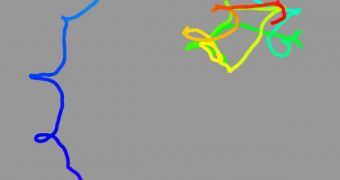Believe it or not, worms can calculate their way to food through a process roughly equivalent to a derivative in calculus. Unfortunately, humans and other animals are also able to do so, although there is still not enough evidence to support this claim. Basically, worms are able to locate food by tasting the environment in different places. They then approximate if the taste becomes stronger or weaker, and the result of the comparison is then used to determine whether or not to change direction.
"The more we know about how taste and smell function - not just at the level of primary sensory neurons, but downstream in the brain - the better prepared we will be to understand when the system is broken," says biologist Shawn Lockery of the University of Oregon, the lead author of the study.
Using some salt and chili peppers, Lockery was able to establish that two anatomically identical neurons inside the worm's brain, responsible for its behavior, respond according to the changes in salt concentrations by flipping 'on' and 'off', much in the same way as logical gates. When the salt concentrations increase, the two neurons fire, telling the worm to continue moving in the same direction. But, when the salt concentrations decrease the worm is most likely to resume course towards the saltiest direction.
This response appeared to indicate that the brain of the worm is capable of calculating derivatives. In mathematics the derivative is a measurement to how a function varies as a result of a change in the input data. So, to test this theory, Lockery started to investigate whether these two neurons would be able to differentiate between salt concentrations. He injected capsaicin in each of the neurons to activate them and observed how the worm would react.
Worms that had their left neuron activated continued their original direction, as their brain suggested that the salt concentration was increasing. But when the right neuron was activated, their brain was tricked into believing that the salt concentrations were decreasing, and the worms started to look for salt in other locations. "We found a new way to do calculus with neurons," Lockery said.
Similar neurons had been previously identified in animals such as fruit flies, cockroaches, frogs, lobsters and rats, and since the olfactory regions of a rat's brain resembles that of mammals, it's not unlikely that humans and other animals use derivative circuits for purposes such as smelling or tasting.

 14 DAY TRIAL //
14 DAY TRIAL //